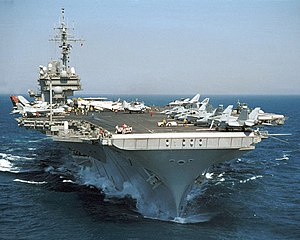Kitty Hawk-class aircraft carrier

USS Kitty Hawk
|
|
| Class overview | |
|---|---|
| Name: | Kitty Hawk class |
| Builders: | |
| Operators: |
|
| Preceded by: | Forrestal class |
| Succeeded by: | Nimitz class |
| Subclasses: | John F. Kennedy class (variant) |
| In commission: | 21 April 1961 – 31 January 2009 |
| Completed: | 3 plus 1 variant |
| Laid up: | 2 |
| Scrapped: | 1 |
| General characteristics | |
| Type: | Aircraft carrier |
| Displacement: |
|
| Length: |
|
| Beam: |
|
| Draft: | 38 ft (12 m) |
| Installed power: | 280,000 shaft horsepower (210 MW) |
| Propulsion: | Westinghouse geared steam turbines, eight steam boilers, four shafts; 280,000 shp (210 MW) |
| Speed: | 32 kn (59 km/h; 37 mph) |
| Range: | 12,000 miles (19,300 km) |
| Crew: | 3150 - Air Wing Crew=2,480 |
| Armament: |
|
| Aircraft carried: | Up to 90 aircraft |
The Kitty Hawk-class supercarriers of the United States Navy were an incremental improvement on the Forrestal-class vessels. Three were built, all in the 1960s, Kitty Hawk (CV-63) (1961–2009), Constellation (CV-64) (1961–2003), America (CV-66) (1965–1996), as well as the variant John F. Kennedy (CV-67) (1967–2007). All are now decommissioned.
The biggest differences from the Forrestals are greater length, and a different placement of elevators; two are forward of the island, one is aft of the island and another on the portside stern. The movement of the #4 elevator from the forward to the after end of the angle made it useful for aircraft movement, since the forward-end elevator in the Forrestals was sited in both the landing path and in the launch path of the waist catapults.
Three different shipyards were used to construct the ships. Kitty Hawk was built at New York Shipbuilding Corporation, Constellation at New York Naval Shipyard, America and John F. Kennedy at Newport News Shipbuilding. John F. Kennedy is similar to the earlier units in flightdeck arrangement and propulsion, but has enough differences that she is placed in her own class. Propulsion consisted of four Westinghouse geared turbines, 280,000 shaft horsepower (210,000 kW), four shafts with eight 1,200 pounds per square inch (8,300 kPa) Foster Wheeler boilers.
The first three units were constructed with a Terrier surface-to-air missile system. The supporting missile launchers and AN/SPG-55 radars consumed a large amount of space, while at the same time duplicating the capabilities of the air defence escorts, and were later removed. John F. Kennedy did not have Terrier and was built with the shorter ranged Sea Sparrow, Basic Point Defense Missile System (BPDMS). All were eventually equipped with NATO Sea Sparrow (NSSM) and Phalanx CIWS for self-defense. In 2001, Kitty Hawk received two Rolling Airframe Missile launchers replacing the forward Sea Sparrow and Phalanx CIWS equipment. The SLQ-32 Electronic Warfare Suite was added as part of the Service Life Extension Program (SLEP) on Kitty Hawk and Constellation.
...
Wikipedia
